#agelenidae
Note
Would it be possible to list some of the general differences between wolf and grass spiders? Thank you!
Sure! Grass spiders are funnel weavers, so you will often find them in funnel-like webs, usually with a big flat sheet of web around it. I see them often on bushes or in corners of siding and windows on houses. And of course over grass. Here's a pic of what you'd commonly see:

Agelenopsis sp. photo by kaden_slone04
Wolf spiders on the other hand are active hunters, so you'd more often see them just running around freely or maybe in a burrow in the ground. They're a common sight in gardens, sometimes females carrying a little white egg sac from her abdomen.
Grass spiders and wolf spiders can look sort of similar, but they're easy to distinguish from one another with a few key features: the eyes and the spinnerets.
Of course there are a bunch of different species with lots of different markings so this is a generalization, but I'll choose two of the more common wolf spiders in the US, the rabid wolf, Rabidosa rabida, and Tigrosa annexa, which as far as I know has no common name. For grass spiders it can be difficult to determine exact species from photos so I'll just use the Agelenopsis genus.
The easiest way to ID wolves is with their eyes! They have 8, with 4 on the bottom row, two great big forward facing eyes in the middle, and then two on top of their head:
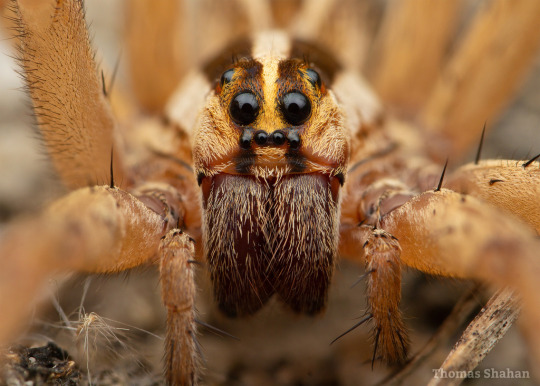
Rabidosa rabida photo by tshahan
And from above:
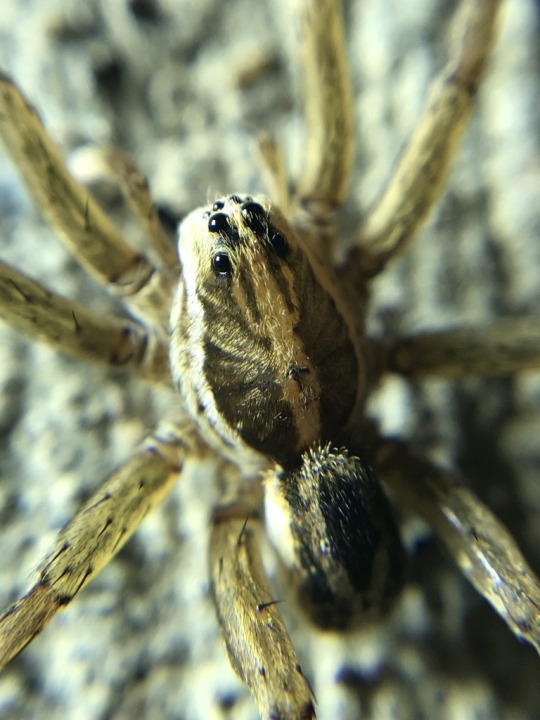
Tigrosa annexa photo by wildcarrot
The eyes are almost always very obvious and easy to spot.
Grass spiders have two eyes on the bottom row, four in the middle, and two on top. The two center eyes in the middle row are not as exaggerated as the two large wolf eyes. Some views of their eyes:


Agelenopsis sp. photos by jasonjdking and tmurray74
Grass spiders also have long, visible spinnerets sticking off the end of the abdomen:

Agelenopsis sp. photo by littlelegofan
Wolves do have spinnerets, but they're not as long and pointy:


R. rabida by schoenitz and T. annexa by wendybirdsbyrv
Hopefully that's helpful!
#bugs#andtheirlovewasrenewed#arachnids#spider#grass spider#agelenidae#agelenopsis#funnel weaver#wolf spider#tigrosa annexa#rabid wolf spider#the more you know
379 notes
·
View notes
Text
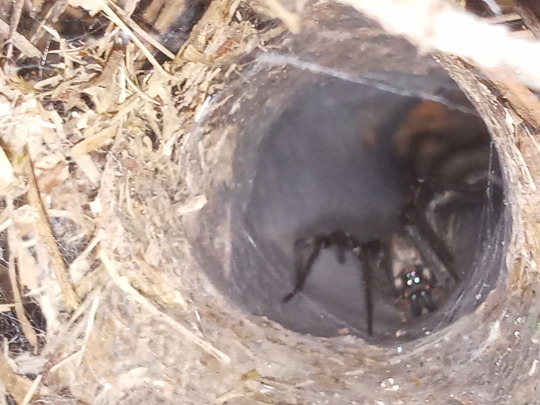

[PHOTOS TAKEN: SEPTEMBER 5TH, 2023 | Image IDs: Two photos of a large grey funnel weaver spider in the far end of its web, a round hole in a pile of beige brown pine needles covered in silk, the spider's eyes seeming to glow a bit from the camera flash /End IDs.]
#funnel weaver#agelenidae#spiders#spider#arachnids#arachnid#arthropods#invertebrates#inverts#photos#photo#Wasp House Sights
18 notes
·
View notes
Text

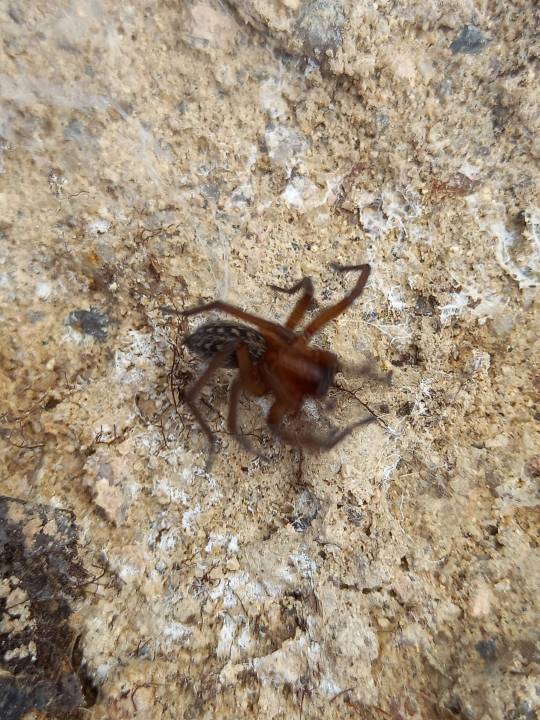


local baby gets startled by Fresh Air after having its rock flipped for 0.2 seconds

trying to play it cool afterwards
2 notes
·
View notes
Text

FUNNEL WEAVERS (Angelenidae): Agelenopsis sp., “American grass spider”
Often mistaken for wolf spiders, and can grow to a similar size. The easiest difference to spot is the long spinnerets, which the wolfs don’t have. (Eyes are different too, just harder to see usually)
#spiders#spider#funnel weavers#Agelenidae#grass spider#this one was biiiig though I swear almost a full inch body length#these aren’t usually that big so I myself was fooled#my photos
9 notes
·
View notes
Text




Grass Spider
Agelenopsis sp.
(Male on left, female on the right)
#spiders#arachnids#nature#bugs#entomology#it’s actually not but for the sake of tagging I am working against my urge for accuracy#agelenopsis#agelenidae#funnel weaver#north american species#grass spiders#my photos#gee I wonder what my favourite animal is lol
17 notes
·
View notes
Text
Bumgs.


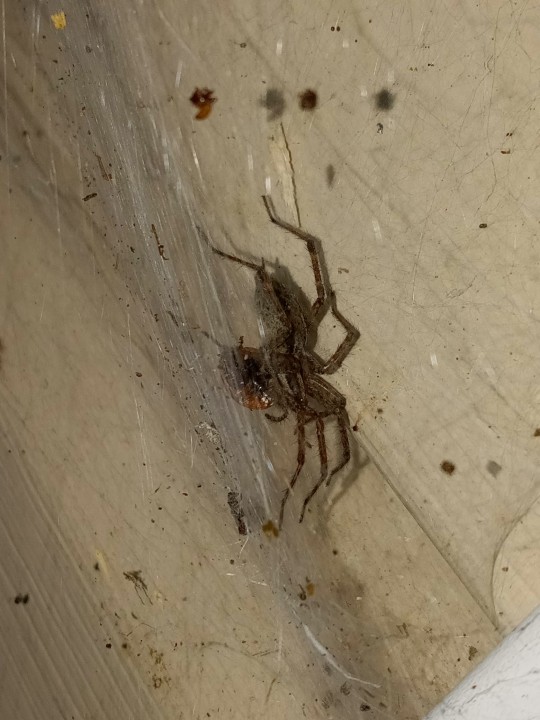

#hymenoptera#grasshopper#wasp#salticidae#flea jumping spider#grass spider#arachnids#spiders#bugs#orthoptera#agelenidae#just some lil lads and lasses#forgot my macro lens#so some nice okay quality bug pictures
0 notes
Link
These species join a large number of invertebrates recently found in Israeli caves that are new to science.
The study was recently published in the Molecular Phylogenetics and Evolution journal, and has extensive scientific implications for uncovering the evolution of speciation in caves and the historical, geographic and climatic processes that occurred in Israel.
Doctoral student Shlomi Aharon led the study under the guidance of Dr. Efrat Gavish-Regev, from the National Natural History Collections at Hebrew University and Professor Dror Hawlena from the Department of Ecology, Evolution and Behavior. The unique conditions in cave habitats, as well as the isolation from other habitats, lead to a process of convergent evolution, in which we observe the development of exceptional adaptations to life in the dark, such as blindness, loss of pigments and enlargement of sensory organs.
"In many cases, these adaptations will lead to the creation of new species, whose distribution is geographically limited in areas with unique ecological conditions, such as a single cave or a system of connected caves," explains Shlomi Aharon.
Continue Reading
427 notes
·
View notes
Text
𝙎𝙋𝙄𝘿𝙀𝙍 - 𝙈𝘼𝙉 ( 2099 ) 𝘿𝙉𝘼 𝙈𝙐𝙏𝘼𝙏𝙄𝙊𝙉𝙎 ... ᵖᵗ¹

miguel o'hara was the head of alchemax's genetic department before and after his mutation . he was tasked to lead a program dedicated to recreating the radioactive mutations sustained by peter parker during the golden age of heroes . only one issue . a hundred years have passed since then , and records of peter parker's powers have since been lost . entailing that this project is entirely resting in the hands of miguel and his fellow geneticists to complete . upon initial human experimentation it is discovered that the project is not in fact ready , as the subject was transformed into a grotesque creature with a thirst for the kill . it was killed immediately .
it is only after o'hara experiences an addiction to rapture at the hands of tyler stone , and a saboteur by the name of aaron delgato that the mutations can be proved to be successful . unfortunately , miguel o'hara is the victim . he is completely transformed , becoming fifty percent aracnid on a genetic level . so which arachnid species is it running through his code ?
the four families included in the experiment were araneidae ( orb weaver ) , ctenidae ( wandering spider ) , sparassidae ( huntsman spider ) , and most predominantly lycosidae ( wolf spider ) .
to dive into specifics , let's begin with the orb weaver family . it was commonly recognized that peter parker shot webs in order to transport . however , it is no longer documented how this effect was achieved . the spotted orb weaver was one of the concluding strands of dna added within the project , and was used to replace the agelenidae ( funnel web ) family strands after a particular weakness and lack of web mobility . however, this test was only conducted on spiders and rats before the family was replaced . the addition of the araneidae family improved webbing constitution , flexibility and quantity . as well as ensured the production of webs , as ctenidae and lycosidae seldom produce anything more than silk for eggsacs .
due to the sheer might of the latter and most predominant familial infusion ( lycosidae ) , the experiment warranted a species that would serve to neutralize the traits of the dominant genus . with the complete extraction of the agelendiae family , one of the more robust and immobile arachnid species , it was left to the geneticists to add a spider far larger in mass to help the rats accommodate new bodily functions , as well as wane some of the more severe redefinitions accompanied with muscle growth and changes . in order to accomplish this , alchemax researchers provided specimens of both the sparassidae ( huntsman spider ) and ctenidae ( wandering spider ) . despite being athletic specimens , both the grey huntsman spider and the brazilian wandering spider are larger in mass than their counterpart of majority , thus may aid the muscles of the mutated to adapt to such athletic and lithe body alterations .
the most dominant of dna strands within this recreation would have to be that of lycosidae , or the wolf spider . deemed the athletes of the arachnid world , lycosidae was the primary candidate and base code for this project . all other codes were implemented to both compliment and accentuate the features of both the rabid wolf spider ( rabidosa rabida ) and the dotted wolf spider ( rabidosa punctulata ) . the former of which a larger species of lycosidae , and named aptly and appropriately for its erratic movements and hunting style . the goal was to entirely replicate peter parker's physical abilities , relying on the genes of the formidable predator to do so . the base of the experiment was conducted with dotted wolf spider strands , perhaps the more well distributed of the wolf spider family . however , as time wore on , geneticists wanted to test how far they could take this accelerated athleticism . they cut out the weak link that was the immobility of the funnel web family , as well as added strands of rabidosa rabida , which improved a great number of aspects within the subject's mobility . however , it was soon discovered that the rats effected would die of implosion due to lack of ability to adapt to such powerful attributes . to improve this , they attempted to add strands of snail dna , hoping to loosen muscles enough to help the body accommodate for the mutations . this experiment failed greatly , and most subjects both did not survive , nor did they meet the criteria to even qualify for the next steps of injection . with that , the team took a step back to analyze the situation . thus eventually concluding that the best thing to do was utilize a weaker strand of dna of an equally as dominating arachnid , one with the body mass to harbor such abilities . because of these strands , majority of the rats developed a larger inclination to hunt , and could not sit still . some died of heart attacks and others flourished .
with this success , the team decided to advance to human experimentation . all except for miguel o'hara .
#ˑ 🕸️ ﹙ ˣ ﹚ » ﹝ head canons ﹞ .#( i think i had like.... 16 tabs open .#( all spider related .#( new special interest up in this bitch .#( everything in this post is PURELY hc .#( i mean EVERYTHING .#( do not rip from this .#( i will 100% absolutely know .#tw // body horror#tw // animal experimentation
10 notes
·
View notes
Text

Agelenidae
6 notes
·
View notes
Text
Family #2: Agelenidae
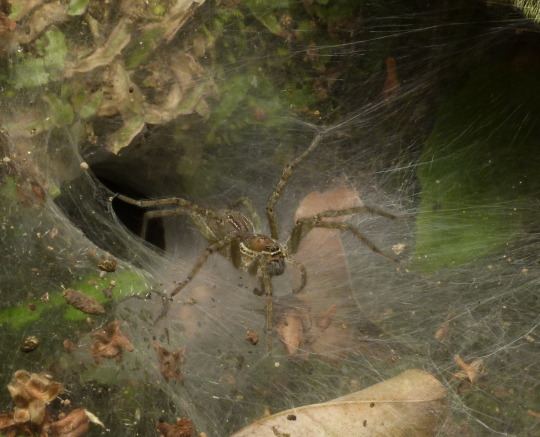
Agelenidae sp. Photo by Shyamal, CC BY-SA 3.0
These are commonly known as funnel web spiders or grass spiders. Keep in mind, however, that they are different from the infamous Sydney funnel web spider, which belongs to an entirely different infraorder and is known to have medically significant venom. Agelenids, on the other hand, are harmless creatures that you can frequently find living in grass, window sills, bushes, and more.
Where the "funnel web" gets its name is somewhat self explanatory. The web has a small, cylindrical retreat which expands out into a sort of sheet. The spider will sit in the smallest part of the funnel, the retreat, until it senses the vibrations of prey on the sheetlike section of the web. At that point, it will run out with lightning speed and take down the prey, pulling it into the retreat.

Agelenopsis sp. Photo by Philip Cohen, CC BY-SA 2.0
As you can see, agelenids have impressively long spinnerets. Specifically, the distal (farthest out) segment of the spinnerets is exceptionally long. A lot of people mistake these for wolf spiders, but if you see the long spinnerets, you can be sure that it's actually an agelenid!
Something fascinating about agelenid webs is that they're not sticky, like you might expect a spider web to be (some orb webs are sticky, but it depends on the type of orb weaver!). Rather, these webs rely on a dense meshwork of threads to entangle their prey long enough for the spider to run out and grab it.
Agelenidae is an extremely broad-ranging family, found on all continents except Antarctica. There are currently 94 recognized genera and a whopping 1380 species!
Information sources can be found below the cut:
World Spider Catalog (2023). World Spider Catalog. Version 24. Natural History Museum Bern, online at http://wsc.nmbe.ch, accessed on {date of access}. doi: 10.24436/2
0 notes
Text
7 nouvelles espèces d'araignées découvertes dans des grottes en Israël
See on Scoop.it - EntomoNews
In a new study conducted by researchers from the Hebrew University of Jerusalem and University of Madison-Wisconsin, seven new species of funnel web spiders (Agelenidae, Tegenaria), unique to caves in Israel, were discovered. These species join a large number of invertebrates recently found in Israeli caves that are new to science.
7 new spider species discovered in caves in Israel
by Hebrew University of Jerusalem, 14.02.2023
Graphical abstract. Credit: Molecular Phylogenetics and Evolution (2023). DOI: 10.1016/j.ympev.2023.107705
-------
NDÉ
Traduction
Dans une nouvelle étude menée par des chercheurs de l'Université hébraïque de Jérusalem et de l'Université de Madison-Wisconsin, sept nouvelles espèces d'araignées à toile en entonnoir (Agelenidae, Tegenaria), uniques aux grottes d'Israël, ont été découvertes. Ces espèces rejoignent un grand nombre d'invertébrés récemment découverts dans les grottes israéliennes et nouveaux pour la science.
L'étude a été récemment publiée dans la revue Molecular Phylogenetics and Evolution, et a des implications scientifiques importantes pour découvrir l'évolution de la spéciation dans les grottes et les processus historiques, géographiques et climatiques qui se sont produits en Israël.
Le doctorant Shlomi Aharon a mené l'étude sous la direction du Dr Efrat Gavish-Regev, des Collections nationales d'histoire naturelle de l'université hébraïque, et du professeur Dror Hawlena du département d'écologie, d'évolution et de comportement. Les conditions uniques des habitats troglodytes, ainsi que l'isolement par rapport aux autres habitats, conduisent à un processus d'évolution convergente, dans lequel on observe le développement d'adaptations exceptionnelles à la vie dans l'obscurité, comme la cécité, la perte de pigments et l'élargissement des organes sensoriels.
"Dans de nombreux cas, ces adaptations conduiront à la création de nouvelles espèces, dont la distribution est géographiquement limitée dans des zones présentant des conditions écologiques uniques, comme une seule grotte ou un système de grottes connectées", explique Shlomi Aharon.
"Dans cette étude, nous avons cherché à comprendre les relations évolutives entre les araignées à toile en entonnoir (Agelenidae, Tegenaria) avec des yeux normaux que l'on trouve à l'entrée des grottes en Israël, et celles qui se trouvent au fond de la grotte et qui sont sans pigment, avec des yeux réduits et même complètement aveugles."
Après avoir collecté les araignées à la main, l'équipe de chercheurs a effectué une série d'examens microscopiques, enregistré la morphologie et extrait l'ADN de chacune d'entre elles pour les comparer aux séquences d'espèces connues du même genre qui existent dans la GenBank.
"Parmi les araignées que nous avons trouvées, cinq étaient uniques à différentes grottes, et les deux autres espèces ont été trouvées dans plusieurs grottes de la Galilée et dans des grottes situées dans le champ karstique d'Ofra, qui est maintenant menacé en raison de plans de construction", explique le Dr Gavish-Regev.
"L'un des résultats surprenants de l'étude montre que les nouvelles espèces sont, du point de vue de l'évolution, plus proches des espèces des grottes des régions méditerranéennes du sud de l'Europe, que des espèces vivant à proximité de celles-ci à l'entrée des grottes en Israël."
Cinq des nouvelles espèces décrites présentaient une réduction des yeux, tandis que les deux autres étaient complètement aveugles. Les chercheurs suggèrent que les nouvelles espèces ont développé des adaptations à la vie dans les habitats souterrains et se sont "spéciées" dans les grottes, après ou simultanément à l'extinction des espèces ancêtres dont elles sont issues, qui vivaient en dehors des grottes et se sont éteintes en raison des changements climatiques historiques dans la région.
"Nous sommes actuellement témoins des effets du changement climatique sur de nombreux habitats, ce qui nous oblige à envisager, maintenir et promouvoir des programmes qui incluent la préservation des habitats souterrains - dont beaucoup sont en danger immédiat", conclut le professeur Hawlena. "Nous devons protéger la nature unique d'Israël, préserver ses systèmes souterrains pour l'avenir et explorer davantage les processus qui ont créé ces systèmes dans le pays."
L'étude
In the land of the blind: exceptional subterranean speciation of cryptic troglobitic spiders of the genus Tegenaria (Araneae: Agelenidae) in Israel - Molecular Phylogenetics and Evolution, 24.01.2023 https://www.sciencedirect.com/science/article/abs/pii/S1055790323000052?via%3Dihub
0 notes
Note
A wolf spider friend! He came out to say hello after christmas! He sat very calmly on my hand for pictures, and even modeled for my relatives for a quick spider anatomy lesson.
Pistachio for scale

He's so handsome. Excellent yegs. Fantastic peets. Sweetest face.

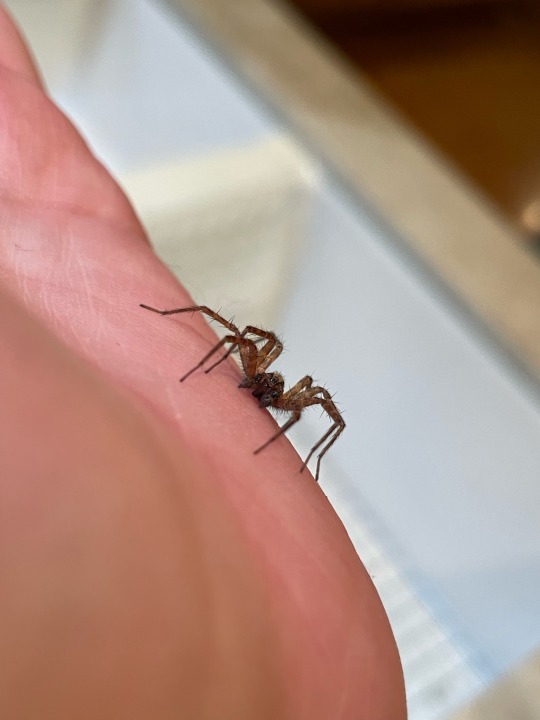

Afterwards, I showed him the hall closet where he could hang out in (if he wanted) where he could enjoy the indoor warmth but still be safe from cats. (There's a gap under the door so he can come out and say hi again :3)
Location: Bay Area, California
What a perfect man! I love his Santa hat. He is, however, not a wolf spider. He's a very lovely funnel weaver in the family Agelenidae. Don't ask me beyond that, though, there are so many and they all look so similar.
203 notes
·
View notes
Text


[PHOTOS TAKEN: DECEMBER 3RD, 2023 | Image IDs: Two photos of a brown, black, and white funnel weaver spider in a glass jar /End IDs.]
#agelenidae#funnel weaver#Spiders#spider#Arachnids#Arachnid#Arthropods#Bugs#Bug#Bugblr#Invertebrates#Inverts#Photos#Photo#Wasp House Sights
15 notes
·
View notes
Text
7 new spider species discovered in caves in Israel#spider #species #discovered #caves #Israel
Graphical abstract. Credit: Molecular Phylogenetics and Evolution (2023). DOI: 10.1016/j.ympev.2023.107705
In a new study conducted by researchers from the Hebrew University of Jerusalem and University of Madison-Wisconsin, seven new species of funnel web spiders (Agelenidae, Tegenaria), unique to caves in Israel, were discovered. These species join a large number of invertebrates recently found…
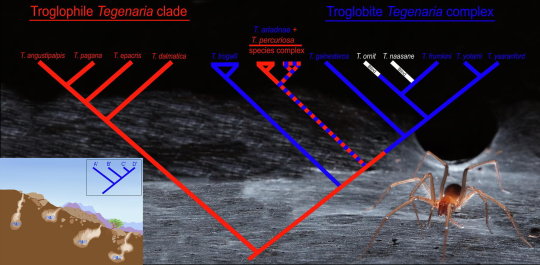
View On WordPress
0 notes
Text

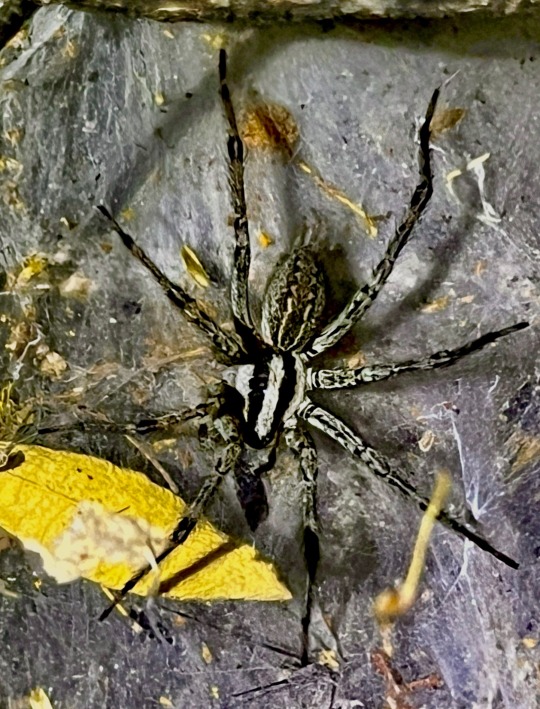
Found a grass spider (Agelenopsis sp)! She was Big.
#spiders#spider#grass spiders#funnel weavers#Agelenidae#my photos#went prowling around the Sonora Desert Museum after dark just to catch spiders who are usually hiding#no tarantulas yet :(
8 notes
·
View notes
Text
Quick follow up! Look, they are quite smol:
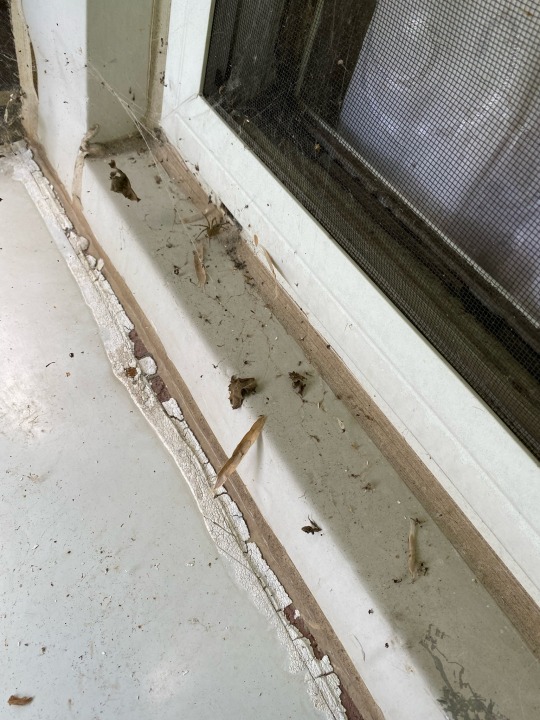
2 notes
·
View notes